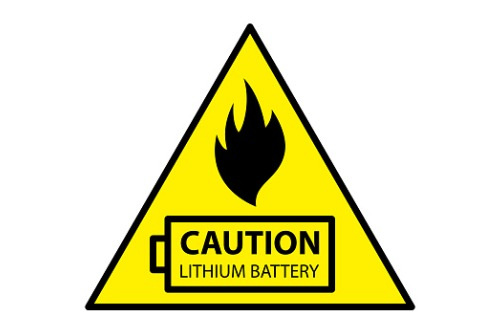8 ways to mitigate health risks in relation Li-Ion batteries

By QBE Senior Risk Manager Nick Fox
Lithium-Ion batteries are found in almost every home, business, and workplace in the modern world. As Li-Ion cells power the lives of millions of people every day, we take a closer look at some of the health and safety risks associated with these batteries.
The risk of fire posed by Lithium-Ion (Li-Ion) batteries is well documented, regularly featuring in headlines and dominating conversations around electric vehicles (EV), battery energy storage systems (BESS) and battery waste handling.
Frequency is growing too; the London Fire Brigade (LFB) reported callouts to battery fires once every two days in 2023, and the running total of ‘e-fires’ in the capital had already outstripped the 116 recorded in 2022 by September
But why are the risks of a Li-Ion fire different to other types of fire?
Thanks to a phenomenon called thermal runaway, within a Li-Ion battery any internal fault or external conditions (such as overcharging or mechanical damage) can begin an irreversible and uncontrollable self-heating state. Once a battery begins heating in a thermal runaway, it can only end one way: with extremely high temperatures, fire, smoke, and vapours.
Thanks to the fast-building intensity of thermal runaway, the time between the fault or damage occurring and the release of toxic vapour during a fire can sometime be just a few minutes, or even seconds.
Additionally, Li-Ion battery fires not only burn for much longer periods than ‘normal’ fires, but they can reignite hours, days, or even weeks later, and multiple times – making the risk much more complex.
While the risk to property is widely discussed in the context of Li-Ion fires, there is less conversation around what risk managers should be aware of when considering health risks in those same events.
Although contact with toxic materials is unlikely when handling Li-Ion batteries in a controlled manner, if the integrity of the battery housing is damaged, or the cell catches fire, the explosion can often be so violent that it shatters the battery. This immediately releases a dangerous shower of fragments, corrosive chemicals, and poisonous vapour – highly hazardous health risks for anyone nearby.
Highly hazardous: the risk to life
Highly toxic combustion products from Li-Ion fires can result in damaging and even fatal health outcomes for those exposed to them.
Vapour clouds can form when a Li-Ion battery explodes without the gases igniting or being vented to atmosphere. Such containment can occur in a closed storage room or a shipping container where there are no immediate ignition sources.
This vapour cloud is not like smoke, it’s a mixture of toxic and explosive gases. Often it will not spread like smoke - due to differences in density it pools at ground level, proving more dangerous to those trained to stay low during a fire to avoid inhalation.
In fact, even in instances where the gases can disperse, there is still the possibility that toxic health effects may occur from brief exposure, albeit at a lower impact.
Battery substances posing serious health risks:
Hydrogen fluoride
Hydrogen fluoride can exist as a colourless gas which, despite dispersing quickly in air, can still enter the body through inhalation. When hydrogen fluoride is dissolved in water, it may be known as hydrofluoric acid, a highly toxic, reactive chemical which enters the body through direct contact.
Health risks include:
• Very serious and extremely painful burns from any skin contact, the extent of which can be missed at initial stages, as it can take up to 24 hours after contact before pain is experienced
• Continued break down of flesh and tissue and damage to organs long after initial efforts have been made to wash it from the skin
• Irreparable damage to the eye even with very small quantities of diluted hydrofluoric acid
• Fatal toxicity by inhalation.
Carbon monoxide and carbon dioxide
Ignition of Li-Ion batteries results in the release of carbon monoxide and carbon dioxide. Both interfere with the absorption and transport of oxygen around the human body, leading to oxygen deprivation of its tissues and organs. Reduced oxygen flow to the bloodstream and cells initially causes:
• Fatigue
• Clumsiness
• Breathlessness
• Confusion
• Increased heart rate. With continued or increased exposure symptoms may worsen to include nausea, vomiting, convulsions, or coma – before progressing to death.
Cobalt
At high temperatures, cobalt is attacked by atmospheric oxygen and by water vapour, producing cobalt (II) oxide. Vomiting and abdominal pain are the results of ingestion, inhalation and/or skin contact with dusts or solutions containing cobalt.
Nickel
The toxicity of nickel metal and inorganic nickel compounds vary depending on their solubility, but short-term effects can include both irritation of the skin (on contact with dust or solutions of soluble nickel salts) and eye irritation (from exposure to nickel dust, fumes, or splashes from nickel-containing solutions). It can also enter the body via inhalation of dust, fumes or mist.
Copper
Owing to its heat and electrical conductivity as well as its resistance to corrosion, ductility, and malleability, copper has many industrial applications and is widely used in electrical wiring and switches. Occupational exposure to copper is usually via inhalation (leading to a fever, headache, fatigue, cough, sore throat and tightening of the chest) and ingestion of contaminated food and liquids (causing stomach pain, nausea, vomiting and diarrhoea).
Aluminium
Aluminium powder is flammable and given an ignition source can ignite on contact with air in a dust explosion. Aluminium reacts with alcohols and water reacts violently with oxidants, strong acids, strong bases, and chlorinated hydrocarbons causing a fire and explosion hazard. Inhalation of aluminium dust can cause irritation of the respiratory tract, whilst ingestion may result in burning in the mouth and throat and mild gastrointestinal upset, and in severe cases, ulceration of the lips and mouth.
Advice for risk managers
Risk prevention strategies are essential to mitigate health risks in relation Li-Ion batteries. In addition to undertaking a fire risk assessment, firms should develop a comprehensive procedure to prepare for emergency events, in consultation with relevant employees.
Emergency procedures should be structured so that all those working with or near Li-Ion batteries have a thorough understanding of actions they should take, alongside any specialist clean-up of released materials.
Employees should be made aware than manual fire extinguishers do not work effectively on Li-Ion battery thermal runaway fires. Extinguishing the flames changes the threat from a fire hazard to an explosion hazard, so employees should evacuate immediately and call the Fire Brigade rather than attempting to tackle a Li-Ion battery fire themselves.
Whilst specific control measures implemented will be guided by an individual site risk assessment, in response to health and safety risks, they are likely to recommend firms to:
- Identify a suitable local exhaust ventilation of the battery charging area
- Establish a requirement to wear suitable personal protective equipment (PPE) including gloves, eye protection, boots, and apron.
- Segregate the charging area: access for authorised personnel only
- Ban metal objects in pockets which could fall onto the battery or bridge across its terminal
- Keep sources of ignition (such as flames, sparks, electrical equipment, hot objects, and mobile phones) away from batteries that are being charged, have recently been charged, or are being moved
- Use suitable single-ended tools with insulated handles, and fit temporary plastic covers over the battery terminals when handling
- Maintain a readily-accessible and in-date supply of the antidote to exposure to hydrofluoric acid – calcium gluconate gel. Whilst suitably trained first aiders can administer the gel, in view of the severity of the effects of exposure to hydrofluoric acid and the swiftness with which it is desirable to apply the antidote, consider specifically training individuals in its application in any area where exposure may occur.
- Ensure hand washing facilities with warm water are available
This guidance has been produced in partnership with Finch Consulting
About QBE
QBE European Operations is part of QBE Insurance Group, one of the world’s leading international insurers and reinsurers and Standard & Poor’s A+ rated. Listed on the Australian Securities Exchange, QBE’s gross written premium for the year ended 31 December 2018 was US$13.7 billion.
As a business insurance specialist, QBE European Operations offers a range of insurance products from the standard suite of property, casualty and motor to the specialist financial lines, marine and energy. All are tailored to the individual needs of our small, medium and large client base.
We understand the crucial role that effective risk management plays in all organisations and work hard to understand our clients’ businesses so that we offer insurance solutions that meet their needs – from complex programmes to simpler e-trading solutions – and support them in minimising their risk exposures. Our expert risk management and rehabilitation practitioners focus on helping clients improve their risk management so that they may benefit from a reduction in claims frequency and costs.

